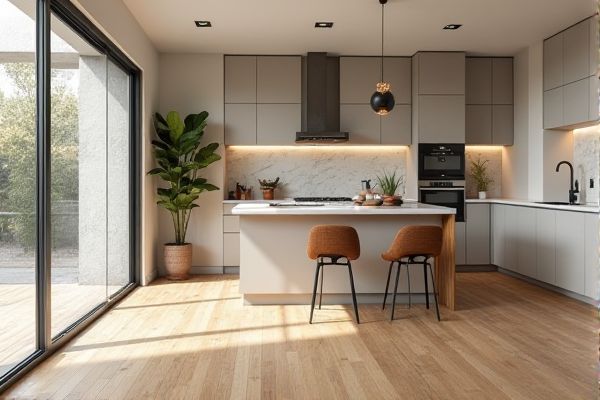
Wood flooring offers warmth and natural beauty that enhances kitchen coziness, while tile flooring provides superior durability and water resistance ideal for high-traffic and spill-prone areas. Discover how each option can impact Your kitchen's style, maintenance, and functionality by reading the full article.
Table of Comparison
| Feature | Wood Flooring | Tile Flooring |
|---|---|---|
| Durability | Moderately durable; prone to scratches and water damage if not sealed properly | Highly durable; resistant to scratches, stains, and water |
| Maintenance | Requires regular sealing and careful cleaning to prevent water damage | Low maintenance; easy to clean with water and mild detergents |
| Comfort | Warmer and softer underfoot | Cooler and harder underfoot |
| Cost | Moderate to high upfront cost; potential for refinishing extends lifespan | Varies from low to high; generally affordable and long-lasting |
| Installation | Requires professional installation; can be time-consuming | Usually simpler and faster installation; DIY possible |
| Appearance | Natural, warm aesthetic with unique grain patterns | Wide variety of styles, colors, and textures |
| Water Resistance | Low resistance; susceptible to warping and stains | High resistance; ideal for wet kitchen environments |
Introduction: Choosing the Right Flooring for Your Kitchen
Wood flooring offers warmth, natural beauty, and comfort underfoot, making it a popular choice for kitchens where style and coziness are desired. Tile flooring provides exceptional durability, water resistance, and easy maintenance, ideal for high-traffic kitchen areas prone to spills and humidity. Comparing factors such as moisture tolerance, wear resistance, and aesthetic preferences helps homeowners select the optimal material for their kitchen environment.
Wood Flooring in Kitchens: Pros and Cons
Wood flooring in kitchens offers a warm, natural aesthetic and excellent comfort underfoot, with options like hardwood and engineered wood providing durability and easy maintenance. It can be prone to water damage, scratches, and dents, requiring proper sealing and prompt cleanup of spills to prevent warping and staining. Wood flooring adds value and charm to kitchens but may need refinishing over time to maintain its appearance.
Tile Flooring in Kitchens: Advantages and Drawbacks
Tile flooring in kitchens offers exceptional durability and resistance to moisture, stains, and scratches, making it ideal for high-traffic and spill-prone environments. Its wide variety of designs, colors, and textures provides versatile aesthetic options, while easy maintenance enhances practicality for busy households. However, tile can be cold and hard underfoot, potentially causing discomfort, and grout lines may require regular cleaning to prevent discoloration.
Durability Comparison: Wood vs. Tile Flooring
Tile flooring offers superior durability in kitchen environments due to its resistance to moisture, scratches, and heavy foot traffic, making it less prone to wear and damage over time. Wood flooring, while aesthetically warm and inviting, can be vulnerable to dents, water stains, and warping if not properly sealed and maintained. Choosing tile flooring ensures long-lasting performance and low maintenance, ideal for the high-use and moisture-prone conditions typical of kitchens.
Maintenance and Cleaning Requirements
Wood flooring in kitchens requires regular sweeping and prompt cleaning of spills to prevent water damage and staining, with periodic refinishing to maintain its appearance. Tile flooring offers superior resistance to moisture and stains, allowing for easier daily cleaning using mop and grout cleaner, but grout lines may need occasional scrubbing or resealing to prevent discoloration. Both materials benefit from routine maintenance, but tile generally demands less intensive upkeep in high-traffic kitchen environments.
Aesthetic Appeal and Design Versatility
Wood flooring offers a warm, natural aesthetic with rich textures and grains that complement rustic, traditional, and modern kitchen designs, enhancing overall ambiance. Tile flooring provides exceptional design versatility through a vast range of colors, patterns, and finishes, allowing for intricate layouts and customization to match any kitchen style. Both options cater to different aesthetic preferences, with wood imparting timeless elegance and tile enabling bold, personalized design statements.
Comfort and Practicality Underfoot
Wood flooring offers superior warmth and cushioning underfoot, making it more comfortable for extended periods of standing or walking in the kitchen. Tile flooring is harder and cooler, which can feel less comfortable but provides excellent durability and easy maintenance against spills and moisture. Choosing wood enhances comfort, while tile excels in practicality and longevity for kitchen use.
Water and Stain Resistance
Tile flooring provides superior water and stain resistance compared to wood flooring, making it an ideal choice for kitchens where spills and moisture are frequent. Porcelain and ceramic tiles offer non-porous surfaces that prevent water penetration and resist staining from common kitchen substances like oils and sauces. Wood flooring, even when sealed, is more vulnerable to water damage and staining, requiring careful maintenance to avoid warping and discoloration.
Installation Costs and Long-Term Value
Wood flooring installation costs typically range from $8 to $14 per square foot, while tile flooring costs vary between $5 and $15 per square foot depending on material type and complexity. Wood offers long-term value through natural warmth and the ability to refinish, extending its lifespan up to 30 years or more with proper care. Tile flooring provides superior durability and water resistance, often lasting 50 years or longer, making it a cost-effective investment despite potentially higher upfront installation expenses.
Final Verdict: Which Flooring is Best for Your Kitchen?
Wood flooring offers warmth and natural beauty with moderate durability and easier installation, making it ideal for kitchens with lower moisture exposure. Tile flooring provides superior water resistance, durability, and ease of maintenance, outperforming in high-traffic or moisture-prone kitchen environments. Choosing the best flooring depends on balancing aesthetic preferences, moisture levels, and long-term maintenance priorities in your kitchen.
 homyna.com
homyna.com